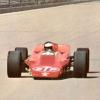Maximum turbo boost on any racing car?
#1

Posted 23 October 2004 - 18:02
Advertisement
#2

Posted 23 October 2004 - 19:01
They weren't the most powerfull turbo's though, cause they still had to work on 1.5L motors so they were fairly small, Turbonetcis have a Y2K unit that makes 2000hp on a petrol engine, some Big V8 run 2 of them 4000hp? Bob Norwood's team built a 4.2L 4 cylinder Funny car that ran 2 turbo's at around 60psi as well making 5000hp with top fuel.
As for OE road cars, manufacturers don't like lag, so the general thinking is to put a small turbo on, this forces them to run mild cams, low stat CR's etc etc so generally a OE turbo system end up around 7-10psi maybe a bit more on some.
As for a aftermarket turbo system, around 20-25psi on pump fuel, if you go low with the static CR(8:1) and have a decent motor to begin with and a good tuner, 30psi might just be possible. If you have a high static CR and have "wild" cams you can also go pretty high.
On race fuel 35psi on the bigger units going any higher is pointeless since you will just be heating the air more, not flowing more.
#3

Posted 24 October 2004 - 07:34
#4

Posted 24 October 2004 - 11:24
Originally posted by david_martin
I seem to recall reading Paul Rosche concluded from telemetry that the BMW F1 "qualifying special" (qualifying specification turbo with the waste blanked off and special ECU settings) that Brabham ran for Nelson Piquet at Monza in 1985 ran at something close to 5 bar peak boost. The engine was only good for about 2 or 3 laps in that configuration. From extrapolation of dyno tables he had on hand, he estimated that was just on 1400 bhp peak power.
And that from four cylinders only, each with a .375 liter capacity. Imagine that, squeezing out 350 bph from a volume equivalent to a half-bottle wine...
#5

Posted 24 October 2004 - 12:30
#6

Posted 25 October 2004 - 05:01
#7

Posted 25 October 2004 - 17:12
#8

Posted 01 November 2004 - 00:57
#9

Posted 01 November 2004 - 11:08
#10

Posted 10 November 2004 - 09:41
Drag Racing Diesel Pickup trucks often run around 150psi of boost. Some of these trucks ( 5,000lbs lightened ) are now running 9's in the 14 mile. We witnessed a 6,000 lb Dodge 4X4 Ram Pickup with a Cummins diesel run 10.8's at Portland International Raceway a couple of years ago
Edit: Ooops...didn't see J.Edlund's post.
#11

Posted 10 November 2004 - 22:32
Originally posted by Chickenman
Been lurking about, so I dug this up. Now, it might not be classified as a car...but they do have four wheels. Diesel Tractor Pulling motors are boosted to 10 to 12 bar, with Two Stage Turbo's and even higher with Triple Staged Turbos' ( Could not find any Data on Boost Pressures for Triple Stage systems ). That would be approx 147 to 176 PSI of boost on a Dual Stage syatem, if I'm not mistaken.
Yes, I have seen this act...quite impressive. Now there is some boost pressure. These boys TIG weld the cylinder heads to the blocks.
#12

Posted 07 December 2004 - 14:09
Originally posted by Evo One
Not a turbo engine but I once read that the BRM V16 1.5 l. s/c had a max boost of 90 PSI - c. 6 bar! on alcohol.
Yes, but they also claimed some 550 hp or thereabout. If so, then these were very crippled horses.
And there isn't much about the BRM V16's I believe in other than the negative tales about it and the fact that it has an engine noise that's worth to risk your eardrums.
I never found out how much boost they ran on exactly but another, high boost engine that `liked` the pressure was the old turbo-Offy at Indy.
Hardly a sophisticated engine ad all but rugged, durable and fairly reliable, Dan Gurney once had one on the dyno and something went wrong with the popoff valve. That 2.65 liter four then produced more than 1400 bhp! On alcohol fuel but without intercooler or sophisiticated engine management etc.that made the 1986 F1 engines so powerful.
In 1973 at Indy, some of the cars with that engine much have had 1200 hp on board during qualifying.
Donohue's 917/30 that year had 1100 and more hp too but with twice as much capacity and thrre times as much cylinders.
A pioneering hallmark engine if it comes to turbocharged machinery: the Drake-Offy 159.
Henri Greuter
#13

Posted 14 January 2005 - 19:13
#14

Posted 21 January 2005 - 03:42
Feel free to correct me if I have got this 20 year old story wrong
#15

Posted 21 January 2005 - 09:09
-airplanes are used over 20 years of time.
-a car's lifetime is about 10 years.
-> if a piece of jet-technology is applied, the engine is worn out even faster.
#16

Posted 24 January 2005 - 13:13
Originally posted by Henri Greuter
Yes, but they also claimed some 550 hp or thereabout. If so, then these were very crippled horses.
And there isn't much about the BRM V16's I believe in other than the negative tales about it and the fact that it has an engine noise that's worth to risk your eardrums.
I never found out how much boost they ran on exactly but another, high boost engine that `liked` the pressure was the old turbo-Offy at Indy.
Hardly a sophisticated engine ad all but rugged, durable and fairly reliable, Dan Gurney once had one on the dyno and something went wrong with the popoff valve. That 2.65 liter four then produced more than 1400 bhp! On alcohol fuel but without intercooler or sophisiticated engine management etc.that made the 1986 F1 engines so powerful.
In 1973 at Indy, some of the cars with that engine much have had 1200 hp on board during qualifying.
Hello Henri!
Oh yes, the Offy Engine is in my mind the astonished race engine in the whole racing since the first GP in France 1906!!
Not a lot of people give this 4 cycl. engine this reputation what the engine has to become, until 1979 the engine was very competitive, than came the Cosworth turbo engine. Basicly the engine´s roots was the Peugeot engine running in Indy. Another famous engine. The drove the Offy until the twenties and she survived round about 50 years! Really astonishing!
My two cent (from the "teuro")
Thomas
Donohue's 917/30 that year had 1100 and more hp too but with twice as much capacity and thrre times as much cylinders.
A pioneering hallmark engine if it comes to turbocharged machinery: the Drake-Offy 159.
Henri Greuter
#17

Posted 24 January 2005 - 13:27
#18

Posted 24 January 2005 - 16:02
Originally posted by Henri Greuter
Dan Gurney once had one on the dyno and something went wrong with the popoff valve. That 2.65 liter four then produced more than 1400 bhp!
I think Foyt used to have that same thing happen during qualifying every year.
You're right, though, the Offy is actually a hell of an engine. They're so simple, yet so effective. They went through such a huge development cycle that they really don't have any weak points. They say with those things that if something breaks, everything breaks.
In retrospect, the death of the Offy engine had massive implications on American open wheel racing. More than ever could have been guessed.
#19

Posted 24 January 2005 - 22:18
Originally posted by clSD139
One thing seems strange to me:
-airplanes are used over 20 years of time.
-a car's lifetime is about 10 years .
-> if a piece of jet-technology is applied, the engine is worn out even faster.
I see you've never been in Brazil or anywhere in South America. Here our cars "lasts" (well, maybe that wouldn't be the most appropriated word) some 30 or even 40 years.
I've took a ride a couple of years ago in a 1966 VW Beetle. Not a "vintage car", conserved by some old collectioner, but a "real" 1966 car, falling into pieces.
Advertisement
#20

Posted 25 January 2005 - 04:35
#21

Posted 25 January 2005 - 05:25
#22

Posted 26 January 2005 - 14:29
intercooler and watercooled turbo are coming soon
but the first 200,000 was without eathor
#23

Posted 27 January 2005 - 03:26
Originally posted by Steve Williams
I seem to remember that the Honda RA168E as used in the Williams in 1986 was good for 5atm and about 1520 hp on a qualifying run. But someone with better knowledge than I would probably know the real answer. I also have a vague recollection of there being ceramic parts in it somewhere but this is probably lost in the sands of time. The reckoning at the time was that non-alloy blocks (eg BMW, Honda) could be boosted more than, say, the Ferrari engine, which reached a point of thermodynamic instability at about 1300-odd hp.
Feel free to correct me if I have got this 20 year old story wrong
I think Renault had both an aluminum alloy block and a iron block (perhaps Ferrari too? I think I read something about that), the TAG-Porsche had four piston rings per piston or something like that to keep it sealed when the cylinders were somewhat deformed. The block to head seal was also a diffucult issue.
There was some ceramic technology in the turbochargers, I've also heard talk about variable geometry.
There are an SAE paper on the Honda engine, there are also a paper about turbocharger developement for F1 by Garrett (I've had plan to buy those but I've never got to it). There are also a book about the Honda engine but it's out of print.


















